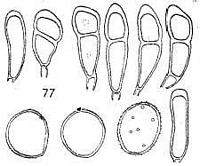|
 Puccinia recondita Puccinia recondita
SynonymsPuccinia elymi
Puccinia dispersa
BiostatusPresent in region - Exotic
Images (click to enlarge)
Caption: FIG. 77. Puccinia Elymi West. on Deyeuxia Forsteri Kunth. Teleutospores, meso. spores,
and uredospores. |
Article: Cunningham, G.H. (1924). The Uredinales, or rust-fungi, of New Zealand: supplement to Part 1; and Part 2. Transactions and Proceedings of the New Zealand Institute 55: 1-58 Wellington:.
Description: 0. Spermogones epiphyllous. crowded in small groups, seated on inflated areas, immersed,
honey-coloured.
1. Aecidia hypophyllous and petiolicolous, crowded in small groups up to 5 mm. diam.,
seated on somewhat inflated areas, orange. Peridia cylindrical, up to 2 mm. high, 0.1-0.3 mm.
diam., margins slightly expanded, not revolute, white, finely laciniate. Spores globose or
elliptical, 18-28 X 15-23 mmm.; epispore hyaline, densely and minutely verruculose, 1-1.5
mmm. thick, cell-contents granular, yellow.
II. Uredosori amphigenous, scattered or crowded, seated on pallid spots, linear, 0.5-1 mm.
long, orange-yellow, pulverulent, surrounded by the ruptured epidermis. Spores subglobose,
elliptical or obovate, 28-32 X 23-26 mmm.; epispore hyaline; finely and closely echinulate, 1-1.5 mmm. thick, cell-contents granular,
orange-yellow; germ-pores scattered, 6-8,
conspicuous.
III. Teleutosori amphigenous, chiefly hypophyllous, and culmicolous, scattered or crowded,
often confluent, linear, 0.5-2 mm. long, dark chestnutbrown, pulvinate, compact, long
covered by the epidermis. Spores ellipticoblong or subclavate, 40-60 X 15-20 mmm.; apex
acuminate, bluntly rounded, or truncate, thickened up to 10 mmm., darker in colour, base
attenuate, basal cell narrower, longer, and lighter in colour than the upper; slightly constricted
at the septum; epispore smooth, chestnut-brown, 1.5-2 mmm. thick in the upper cell, 1-1-5
mmm. in the lower; pedicel persistent, hyaline, tinted beneath the spore, short, up to 15 X 6
mmm.; germ-pore of the upper cell apical, obscure, basal pore immediately beneath the
septum, obscure.
X. Mesospores not uncommon, elongate-elliptical, up to 40 X 12 mmm.
Distribution: Distribution: Europe; Asia Minor; Japan; North and South America; Australia.
Notes: One host is indigenous and widely spread throughout; it occurs also in Australia and
Tasmania (Cheeseman, 1906, p. 868). The other is widely cultivated throughout the world.
Arthur has by a long series of cultures shown that this species consists of numerous races
formerly considered to be distinct species. These so-called species were separated on account
of the fact that the aecidia were known to occur on several hosts; but until the necessary
cultural work had been performed by Arthur apparently no attempt had been made to
ascertain whether these races were in any way associated. His arrangement of these races
under the one species is followed here, and the synonymy, given above taken from his paper
in North American Flora, vol. 7, p. 333, 1920. In this paper he records fifty-nine aecidial
hosts (all belonging to the family Ranunculaceae) and ninety-three telial hosts belonging to
the Poaceae.
The genus Rostrupia Lagerh. was based on abnormal 3-4-celled forms of the teleutospores of
this species.
It may be mentioned that Arthur includes here P. agropyrina Erikss. and P. triticina Erikss.,
two races formerly included under P. dispersa Erikss. et Henn. Although not sufficiently
differentiated to separate as distinct species, these two forms may in the uredo stage be
separated on account of the ferruginous colour of the uredosori.
Article: McKenzie, E.H.C. (2008). Rust fungi in the subantarctic islands of New Zealand. Mycoscience 49: 1-10 Mycological Society of Japan.
Notes: A widespread rust, especially in temperate areas of the world. Occurs throughout New Zealand on a range of mainly introduced grasses. Puccinia recondita is a “species complex.”
Article: Dingley, J.M. (1969). Records of plant diseases in New Zealand. New Zealand Department of Scientific and Industrial Research, Bulletin 192: 298 p. Wellington:.
Notes: McNabb (19626) stated that this fungus had previously been recorded by Cunningham (1931a) as
Puccinia elymi. Owing to overseas investigations P. elymi had been accepted as a separate
species not occurring on cereal and not present in New Zealand (McNabb, 1962b). With the
exception of Agropyron scabrum and Deyeuxia forsteri all host plants of leaf rust (Puccinia
recondita) are introduced grass species. The aecidial stage is not present in New Zealand. Allen
(1961b) stated that the losses due to leaf rust are not known; some years it may have been severe
but usually late in the season when wheat yields did not suffer any obvious damage. Results of
observations on variety trials would suggest that `Arawa', 'Dreadnought', `Hilgendorf (1947)', and
`Hilgendorf (1961)' are resistant to leaf rust but as there are over 100 physiological races known of
this rust, the relative resistance of these varieties is likely to change (Allen, 1961 b).
|